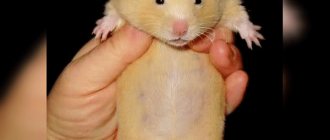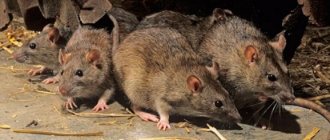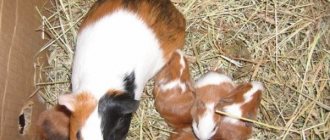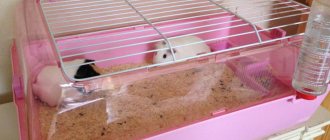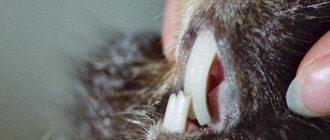How long do hamsters stay pregnant, how to recognize and determine pregnancy in Djungarian and Syrian hamsters, and how to care for a pregnant female before and after giving birth - that’s what this article will discuss.
Breeding Syrian and Djungarian hamsters is not an easy task, having many nuances, features and difficulties. That is why breeders need to be well versed in issues related to hamster pregnancy - how long hamsters stay pregnant, how hamsters give birth, what care a pregnant female needs, what food is best to choose for the periods before and after childbirth.
How to determine pregnancy in a hamster?
It must be said that if the moment of mating was not noticed, then it is unlikely that it will be possible to immediately determine whether the female is pregnant. This can only be assumed by changed behavior. The following signs are possible:
- increased excitability and aggressiveness or, conversely, complete calm and relaxation;
- collecting materials for the nest;
- increased appetite.
The most obvious indicator is an enlarged abdomen, but if this becomes noticeable, it means that labor is coming soon. You can also determine pregnancy by the cessation of estrus and swollen nipples.
Photo of a pregnant Syrian hamster
How long does a hamster's pregnancy last?
For different species of hamsters, the gestation period varies quite significantly. Gestation period in days:
- Syriac – 16 – 18;
- Dzungarian, Chinese, Campbell - 18 - 21;
- Roborovsky – 23 – 30.
If you carefully examine Syrian hamsters a week after mating, and Djungarian hamsters after 9 days, you can feel small fruit balls in the stomach. At the same time, the nipples swell and weight begins to gain. If this does not happen, you need to look for deficiencies either in the diet or in the pet’s health.
The nuances of determining the sex of a pet
It is much easier to identify the sex of a mature hamster than of a baby. At the age of 35-40 days, the rodent’s organs are already perfectly formed; the weight of a representative of the Syrian breed is 150 g, and that of the Dzungarian breed is 50 g. During an external examination, you should pay attention to:
- “bald patch” between the anus and urethra;
- presence of nipples;
- body size.
Males have a distance between the anal and urethral openings - approximately 1.5 cm. If it is absent and the vegetation in the indicated place is sparse, then the hamster is a girl.
Does pregnancy differ between species?
In the table we note what behavioral features are characteristic of different hamsters.
| Aggression towards the male | Nesting behavior | |
| Syrian | It appears brightly, the female can injure or even kill the male, after mating it is necessary to place them in different cages | Very pronounced |
| Dzungarian | Maybe, but sometimes absent (manifests individually), it is recommended to separate | Characteristic |
| Campbell | The male can be with the female and even participate in raising the offspring | Present |
Do false pregnancies occur in hamsters?
A situation is possible when all the signs are present, but labor does not occur. In this case, we can talk about a false pregnancy. This happens to hamsters. In addition, under the influence of stressful situations, the formed embryos can simply dissolve. If such failures occur in pets, it is better to consult a veterinarian.
Pregnant Djungarian hamster
Treatment of offspring
It is strictly forbidden to touch the baby hamsters - if the female smells a human scent on the baby, she will refuse it. If the birth was successful and the cubs do not need artificial feeding, they can be picked up 2 weeks after birth.
The acquaintance of hamsters with their owner occurs gradually. Babies from two weeks and older begin to accustom themselves to the owner’s hands and their smell. At this age, you can visually determine the sex of the cubs. 3-week-old hamsters are already allowed to play. At this point you should also return to regular cage cleaning.
Caring for a pregnant hamster
First of all, the female needs rest during this period. As soon as it is determined that pregnancy has indeed occurred, you need to move the cage to a quiet place. It is better to replace the usual housing with a sufficiently voluminous glass container to prevent the babies from falling out through the bars in the future. It is necessary to provide the hamster with material for building a nest; this can be paper napkins without dyes.
The house must be cleaned regularly and even more thoroughly than usual, since during this period the female diligently stores food, which can spoil.
Adult Djungarian hamster
You should pick up your pet carefully and only if absolutely necessary. At the same time, you should take care to protect your hands (for example, with gloves), otherwise the hamster may scratch or bite.
Approximately 4 days before giving birth, all contact with the animal should be stopped.
We improve living conditions
A pregnant woman definitely needs a house or a nest.
If there is no house in the enclosure, then from the beginning of pregnancy you need to take care of the future nest and provide the hamster with a large number of soft, non-scented napkins and scraps of warm textiles; the animal itself is able to prepare a cozy sleeping place for itself.
Any suitable sized cardboard box will be suitable as a house or shelter. In the absence of a box, it is better to block the ceiling and side walls of the cage from the penetration of bright light. After building a nest, the hamster’s home is strictly forbidden to be touched until the cubs reach 2 weeks of age.
Nutritional features of a pregnant hamster
In order for the female to bear and raise healthy young without being harmed, her diet must be supplemented with calcium, protein foods and vitamins. The following products should be included in the menu:
- chicken meat;
- low-fat cottage cheese;
- eggs;
- vegetables (beets, carrots);
- sprouted cereal seeds;
- greens, juicy herbs.
Of the first three listed components, one should be in the diet daily. You need to be careful with green and succulent foods so as not to cause diarrhea in your pet, but they must be included.
Little hamsters
The lack of calcium can be compensated for by adding a tablet containing this element, or simply crushed chalk, to drinking water. The same can be done with ascorbic acid.
It is better not to give perishable foods in large quantities, as the female can hide them, and this will further contribute to the development of various infections.
What to treat the kids with?
The newborn hamster's menu initially includes only hamster milk. If the female does not lose it, then the milk diet can form the basis of the cub’s diet for a whole month.
But you cannot limit feeding hamsters with mother's milk. The owner’s task is to promptly introduce baby hamsters to other foods so that they develop normally and can eat well in the future.
Additional complementary feeding begins with fermented milk. Then the hamsters are fed porridge with yogurt. From 9 days old, the hamster should be given greens, grains, vegetables and fruits to try.
Correct introduction of new “adult” food will allow a one-month-old hamster to begin a full independent life, and his body will learn to process solid food.
Solo content or in company
Campbell's hamsters get along well together. Sometimes the female and male jungariki are loyal to each other. But this is rather an exception to the rule. Fighting for territory is more typical for these rodents, so it is better to keep them separately, placing the female with the male only during mating. Even a Campbell's hamster will do better alone before giving birth.
Don't handle small hamsters with your bare hands
Help with labor difficulties
Typically, childbirth in hamsters is not accompanied by problems or complications. But in rare cases, situations arise in which the animal requires immediate help. These include:
- long contractions;
- toxicosis;
- fetal obstruction.
All this threatens the life of both the female and the offspring. In case of prolonged contractions or obstruction, immediate intervention by a veterinarian is needed - he will perform an artificial birth or caesarean section.
With toxicosis, it is impossible to save the animals. Both the babies and the hamster die from this complication.
How does childbirth proceed?
Hamsters usually do not require assistance during childbirth. The only exception is when the time of mating is known exactly and the hamster is already “overcoming” her term, then it makes sense to contact a veterinarian. Moreover, for about 4 weeks after the birth of the offspring, there is no need to disturb the female, just carefully add water and food. Even cleaning should not be done for 8 days, and then carry it out carefully, without touching the nest.
During normal labor, labor lasts about 3 hours; if it lasts up to 6, this is still within normal limits. The hamsters appear at intervals of approximately 5 minutes, completely without hair, with their eyes and ears closed. The female gnaws the umbilical cord and eats it along with the amniotic sac of each baby. When the offspring are numerous, the mother may not have time to cope, then some of the hamsters die.
All hamsters are born blind
If it is a Syrian hamster, it is absolutely forbidden to interfere. For the first two days, it is not even recommended to remove dead hamsters. You can try to help the baby dwarf, take it (not with your bare hands) on a napkin, free it from the bubble and gently massage it. Then you need to return it to its mother and see if she accepts this hamster. If the female refuses to feed, you will have to feed him artificially.
A female hamster can give birth to from 4 to 12 babies (there are known cases of the birth of 18 hamsters), but she, as a rule, eats sick and non-viable ones. A hamster eats or refuses to feed its offspring in several cases:
- if you feel weak or unhealthy (with an unbalanced diet);
- when she was disturbed (due to stress);
- if he senses a foreign smell on the cubs.
After 4-5 weeks, the hamsters become adults and need to be placed in separate housing; only females can be left with their mother longer.
We improve living conditions
If the animal’s cage is not equipped with an additional internal house or other “shelter” where the female can place her babies, you should take care of this immediately after the news of the upcoming replenishment.
You don't have to buy a house. The construction of the nest can be left to the hamster directly. She will happily arrange the “nursery” on her own
It is important to help her with building materials. All kinds of shreds and napkins (without aromatic additives) are perfect for this role.
The basis of the house can be a cardboard box of the appropriate size.
After the female has completed construction, touching the hamsters’ home is strictly prohibited. This ban lasts until the newborn reaches 2 weeks of age.
Nutrition for hamsters and female hamsters after birth
The female's diet after childbirth should remain enhanced, since a lot of energy is spent on lactation. Even with such nutrition, the hamster loses up to 25% of its weight during this period. All products that were given to the animal during pregnancy remain on the menu. It is also necessary to monitor the drinking regime in order to produce a sufficient amount of milk; the female needs a lot of liquid.
Newborn hamsters eat baby food
Small hamsters, when they stand on their legs, become very active, and they also require a large amount of calories. Solid foods are introduced gradually; canned food for children can be used. Among cereals, imported small grain mixtures are best suited.
If you follow all the necessary recommendations, you can get healthy offspring from one female 3-4 times during her life. The most suitable age for a hamster to give birth is from 3 to 12 months.
Great article 24
